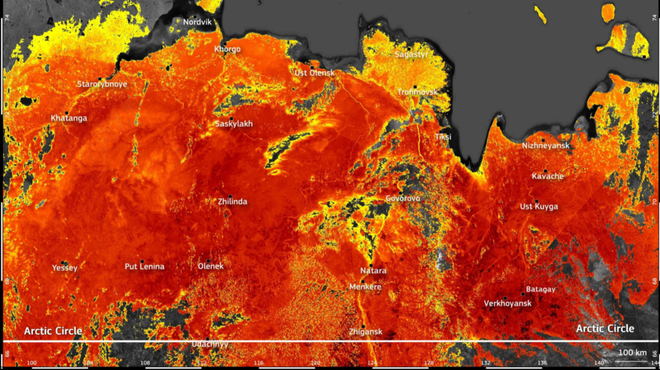The frozen land of Siberia is now hotter than ever, the ground temperature is up to 48 degrees Celsius
- Tram Ho
While many west coast cities like Phoenix and Salt Lake have experienced prolonged hot weather over the past week, the same has happened in the Arctic Circle – 66° 33′ 39 vĩ north of the road. Equator. (Geographically, the North Pole is defined as the region within the arctic circle.)
Accordingly, a temperature of 48 degrees Celsius was recorded by scientists in the town of Verkhojansk in the Republic of Yakutia, in eastern Siberia, according to data from the European Space Agency’s Copernicus Sentinel satellite.

Ground temperatures across Siberia have hit record highs during the region’s heatwave.
In some other areas of the Arctic Circle, ground temperatures were measured at 43 degrees Celsius (in Govorovo) and 37 degrees Celsius (in Saskylah), the highest since 1936. It should be noted, this is the surface temperature. soil, not air temperature. The air temperature in Verkhojansk is 30 degrees Celsius – still unusually hot for an area located near the North Pole.
According to scientists, such high ground temperatures bring a lot of environmental impacts in the Arctic Circle. Specifically, high temperatures affect the permafrost layer, which is ‘capturing’ a lot of greenhouse gases. As the permafrost melts, this layer of soil releases methane into the atmosphere.
In addition to the negative impact of the increase in greenhouse gases in the atmosphere, the melting of permafrost also destabilizes the ground in Siberia, invisibly causing the foundations of buildings to be shaken or seriously eroded. In particular, when the permafrost melts, it also reveals many carcasses of animals that lived tens of thousands of years ago, which are preserved intact.
The area experienced a heat wave that led to temperatures reaching 38 degrees Celsius a year ago. The World Meteorological Organization (WMO) is monitoring the rise in temperatures across the Earth. According to the organization, the most dramatic change is in the Arctic, which is warming at a rate more than twice the world average.
A year ago, the area also suffered a heat wave that led to the air temperature in Siberia reaching 38 degrees Celsius – the highest on record, the hottest ever recorded here. In Western Siberia, the temperature here has reached 32 degrees Celsius. This shows that the global climate is really changing in a negative direction.
Earlier this year, scientists also discovered hundreds of billions of tons of organic carbon and methane hidden deep in the permafrost layer in the Arctic Ocean that are in danger of escaping to the outside, seriously threatening the Earth’s climate. .
Refer to Gizmodo
Source : Genk
